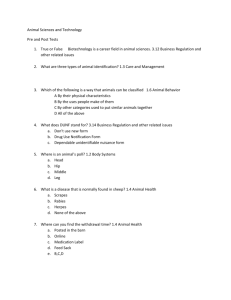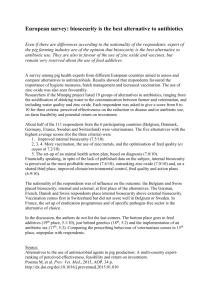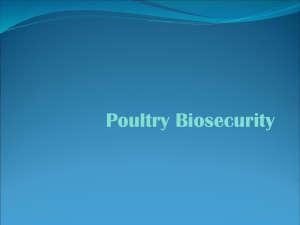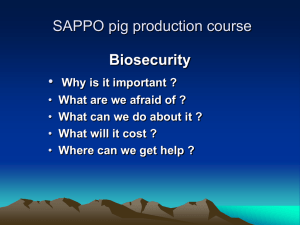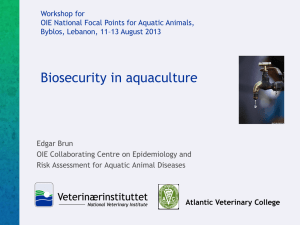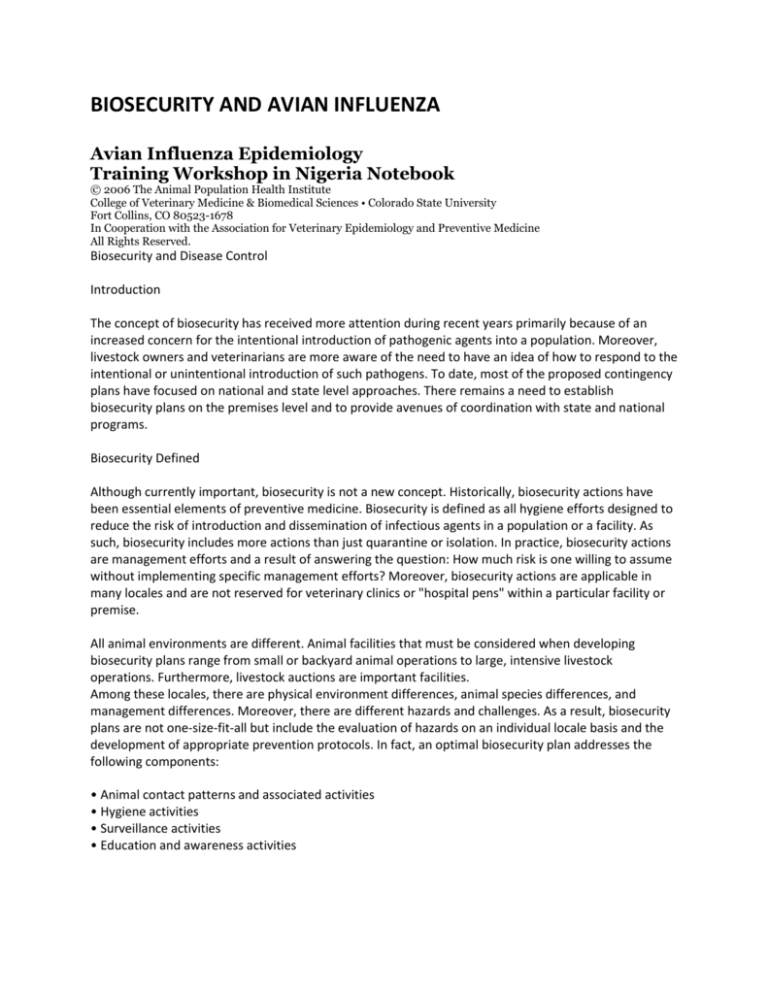
BIOSECURITY AND AVIAN INFLUENZA
Avian Influenza Epidemiology
Training Workshop in Nigeria Notebook
© 2006 The Animal Population Health Institute
College of Veterinary Medicine & Biomedical Sciences • Colorado State University
Fort Collins, CO 80523-1678
In Cooperation with the Association for Veterinary Epidemiology and Preventive Medicine
All Rights Reserved.
Biosecurity and Disease Control
Introduction
The concept of biosecurity has received more attention during recent years primarily because of an
increased concern for the intentional introduction of pathogenic agents into a population. Moreover,
livestock owners and veterinarians are more aware of the need to have an idea of how to respond to the
intentional or unintentional introduction of such pathogens. To date, most of the proposed contingency
plans have focused on national and state level approaches. There remains a need to establish
biosecurity plans on the premises level and to provide avenues of coordination with state and national
programs.
Biosecurity Defined
Although currently important, biosecurity is not a new concept. Historically, biosecurity actions have
been essential elements of preventive medicine. Biosecurity is defined as all hygiene efforts designed to
reduce the risk of introduction and dissemination of infectious agents in a population or a facility. As
such, biosecurity includes more actions than just quarantine or isolation. In practice, biosecurity actions
are management efforts and a result of answering the question: How much risk is one willing to assume
without implementing specific management efforts? Moreover, biosecurity actions are applicable in
many locales and are not reserved for veterinary clinics or "hospital pens" within a particular facility or
premise.
All animal environments are different. Animal facilities that must be considered when developing
biosecurity plans range from small or backyard animal operations to large, intensive livestock
operations. Furthermore, livestock auctions are important facilities.
Among these locales, there are physical environment differences, animal species differences, and
management differences. Moreover, there are different hazards and challenges. As a result, biosecurity
plans are not one-size-fit-all but include the evaluation of hazards on an individual locale basis and the
development of appropriate prevention protocols. In fact, an optimal biosecurity plan addresses the
following components:
• Animal contact patterns and associated activities
• Hygiene activities
• Surveillance activities
• Education and awareness activities
Components of Biosecurity Plan
By addressing components of the epidemiological triad (host, agent, environment) that are unique to
the specific locale, a biosecurity plan seeks to break disease transmission cycles, optimize hygiene,
implement surveillance to target management efforts, and provide education and awareness activities
to maximize participation. To do so, an optimal biosecurity plan provides options for the following four
categories:
• Animal contact patterns and associated activities
• Hygiene activities
• Surveillance activities
• Education and awareness activities
Specific points that should be considered for creating a biosecurity plan are provided for each category.
Animal contact patterns and associated activities
• address direct contact among animals including special risk groups, management groups and traffic
patterns
• address indirect contact among animals including personnel management and contact protocols
• address animal hygiene issues including cleanliness and barrier precautions
• address issues concerning the lifecycle and transmission of infectious disease agents including the
agent's route of transmission, persistence in the environment and infectivity
Hygiene activities
• address the environment including facility design & protocols
• address equipment including segregation, use & cleaning protocols
• address personnel including hand hygiene, foot ware & clothing issues
• address animals
Surveillance activities
• address protocol compliance
• address disease occurrence among high risk patients and due to high risk agents
• address environmental contamination
• address choice of population to select for surveillance -- the general population, targeted population
or both
• address choice of syndromic or etiologic surveillance
Education & awareness activities
• address standard operating procedures (SOPs)
• address facility/premise hazards & consequences to personnel, animals, economics
• address prevention methods
• address outreach
Design of a Biosecurity Plan
Design of a biosecurity plan, which is specific to a particular locale, requires evaluation of identified risks
before design and evaluation of the control system. Although there are three main methods for directed
action against disease in an animal population: disease prevention, disease control, and disease
eradication, the aim of biosecurity is disease prevention!
Disease prevention
Disease prevention is the ideal and can be obtained through the exclusion of a disease from a
population of unaffected animals or through the protection of animals when the disease is present in a
population.
Several measures are available to accomplish disease exclusion.
• First, potentially sick or exposed animals can be quarantined. This activity requires a prior knowledge
of the disease agent and its incubation period for effectiveness.
• Second, animals can be tested prior to joining a specific disease-free population. For this strategy to be
effective, adequate screening and diagnostic tests must be available so there is high confidence in any
negative test results.
• Third, to prevent disease in animals within a population where disease is present, a variety of
protective measures can be taken. Methods of protection include immunization, chemoprophylaxis,
environmental sanitation, genetic engineering and selective breeding, and public awareness coupled
with education.
o Immunization is the most common method of protecting individual animals from disease, if an
effective and safe vaccine is available.
o Chemoprophylaxis or the administration of medication on a routine basis to protect individual animals
from disease requires an effectual, cost effective, and safe drug.
o Environmental sanitation, including vector control, is an effective means to protect animals from
disease. Sanitation efforts do not require extensive knowledge about a particular disease agent and are
effective against many different agents.
o Genetic engineering and selective breeding as a protective measure is limited in its use and has the
potential for long-term negative impacts.
o Public awareness coupled with education is an important protective measure when the disease is a
zoonosis.
Disease control
If disease control is needed within a defined population, control measures include the prevention
activities mentioned above and several additional approaches.
• First, disease can be controlled within the population by decreasing communicability by decreasing
contacts with sick animals. Options to achieve this include segregating ill animals and using an "all-in-allout" practice of herd management.
• Second, disease can be controlled within the population by increasing resistance to the agent within
the healthy portion of the population.
• Third, disease can be controlled within the population by detecting the disease early.
This approach requires an active search for cases -- surveillance!
Disease eradication
Eradication of disease requires elimination of the agent from a specific geographical region or specific
premises as well as from selected host species. This constitutes the ultimate action against a disease.
Eradication of a disease is difficult to accomplish and difficult to maintain.
Therefore, the focus of any eradication effort should be on a specific region, specific premises, a specific
shelter, or a specific home. Methods of eradication include the following options.
• Mass treatment regardless of the disease status of an individual within the population.
• Mass immunization
• Quarantine
• Selective slaughter of diseased animals
• Depopulation or elimination of animals that either are exposed to the disease or show symptoms of
the disease.
No single action against a disease is sufficient. In order to select the proper actions for prevention,
control, or eradication of a disease within an animal population, knowledge about the epidemiology of
the disease is required. One must know factors pertaining to the host, pertaining to the agent, and
pertaining to the particular environment in which the disease is found. In addition, factors related to
social, political, and environmental conditions must be considered before recommending a specific set
of actions.
Essential Elements for Non-endemic Pathogens
The prevention, control, and eradication activities provided above are useful but three essential
fundamentals must be addressed when dealing with non-endemic or exotic pathogens. First, the
pathogens must be kept outside of the premises through exclusion. Second, surveillance strategies must
include checking for the unexpected. Third, a plan of action or intervention must be in place.
Because pathogens move with animals, people and equipment and movement is an essential activity on
most operations, a zero risk for exotic pathogen introduction does not exist.
Quarantine and isolation are usually NOT adequate. Therefore, additional measures for non-endemic
pathogen exclusion should focus on adequate screening, documenting sources of new animals,
restricting animal movement and restricting trafficking before eventual mingling.
To incorporate checking for the unexpected in a surveillance plan, the following inclusions are
recommended for non-endemic pathogens. The monitoring program should include production
parameters. All record keeping should be systematic and include a syndromic monitoring system.
Include negative reporting as an essential component and provide a notification process within and
among herds and premises.
Last, intervention strategies for non-endemic pathogens rely on readiness for the worst case scenario. A
practical plan should be in place, which is executable with a reasonable likelihood of successful, rapid
implementation. Furthermore, the plan documentation should include a list of important pathogens and
related diseases and provide details of possible intervention measures. It is important to realize that
traditional interventions such as vaccination may not be reasonable. Second, known cleaning and
disinfection protocols may not be appropriate for an exotic pathogen. Third, mass treatment as a
preventive measure may not be available. Fourth, the destruction of infected animals may have a huge,
unknown environmental impact. As a result of all of the above, it is important to coordinate with others
and share information and strategies.

